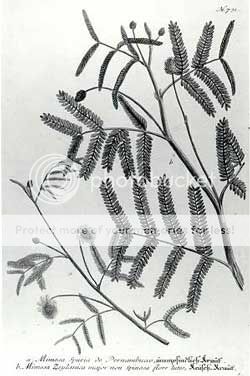Hi gang, not much going on today. Thunder showers most of the day so far. I think my grass has grown an inch! We have the rain coming up from the Golf.
Brenda wrote about the Kudzu plant, the vine that grows a foot a minute. Today I started gathering data on another fast growing plant. We have them everywhere!
THE MIMISO
I think they are beautiful, and I love the smell. The smell can over power you if you are among a lot of them. I have often wondered why no one ever made a perfume from them.


Mimosa is a medium-sized tree that is a continual problem along some roadsides and streams in the Smokes. It seeds prolifically and resprouts quickly when cut. Mimosa seeds may remain viable for 50 years or more. The tree is native to Asia and was introduced to this country in 1745. Park crews have spent up to 600 work hours per year controlling mimosa
(m m ´s ) (KEY), any tree, shrub, or herb of the genus Mimosa of the family Leguminosae (pulse family), chiefly tropical plants. They usually have feathery foliage and rounded clusters of fragrant pinkish flowers atop the branches. Mimosas are used for ornamental purposes in warm regions. The yellow-flowered plants sold as mimosa by florists are usually of the related genus Acacia (see acacia). Most widely known of the mimosas is the sensitive plant (M. pudica), considered a weed in the American tropics but cultivated as a greenhouse annual elsewhere because its leaves fold up and collapse under stimulus (e.g., touch, darkness, or drought) until the whole plant may assume temporarily a thoroughly wilted appearance. It is now naturalized in many warm regions and grows wild in the Gulf States. The name sensitive plant is also applied to other plants of this family that show similar movements. Mimosa is classified in the division Magnoliophyta, class Magnoliopsida, order Rosales, family Leguminosae.
Weed Description: A prostrate perennial that develops into a tree and may reach 40 feet in height. Found throughout the southeastern United States along roadsides, woodland edges, in turf, and also most recently as seedlings or sprouts in many no-till crops.
Silk Tree Mimosa
Albizia julibrissia
Family LeguminosaCharacteristics:
* Leaves compound with many leaflets, 9-12".
* Leaflets curved-oblong, 1/4" wide.
* Flower pink, delicate, silky, making the tree look as if it's covered with silken threads.
* Height: To 40'.
Natural History:
* Habitat: Mostly planted as an ornamental tree.
* Range: Iran to Japan but naturalized in the southeastern United States.
* Introduced from Asia
This is the most common around our area. I have one in the back yard that is forty feet tall.


Would you believe by 1997 the US was paying $200,000,000.00 to control these plants. I wander what the cost is today?
Thought for the day, I saw a deer sleeping in a black berry patch this morning!
Word for the day; Splutter.
Brenda wrote about the Kudzu plant, the vine that grows a foot a minute. Today I started gathering data on another fast growing plant. We have them everywhere!
THE MIMISO
I think they are beautiful, and I love the smell. The smell can over power you if you are among a lot of them. I have often wondered why no one ever made a perfume from them.


Mimosa is a medium-sized tree that is a continual problem along some roadsides and streams in the Smokes. It seeds prolifically and resprouts quickly when cut. Mimosa seeds may remain viable for 50 years or more. The tree is native to Asia and was introduced to this country in 1745. Park crews have spent up to 600 work hours per year controlling mimosa
(m m ´s ) (KEY), any tree, shrub, or herb of the genus Mimosa of the family Leguminosae (pulse family), chiefly tropical plants. They usually have feathery foliage and rounded clusters of fragrant pinkish flowers atop the branches. Mimosas are used for ornamental purposes in warm regions. The yellow-flowered plants sold as mimosa by florists are usually of the related genus Acacia (see acacia). Most widely known of the mimosas is the sensitive plant (M. pudica), considered a weed in the American tropics but cultivated as a greenhouse annual elsewhere because its leaves fold up and collapse under stimulus (e.g., touch, darkness, or drought) until the whole plant may assume temporarily a thoroughly wilted appearance. It is now naturalized in many warm regions and grows wild in the Gulf States. The name sensitive plant is also applied to other plants of this family that show similar movements. Mimosa is classified in the division Magnoliophyta, class Magnoliopsida, order Rosales, family Leguminosae.
Weed Description: A prostrate perennial that develops into a tree and may reach 40 feet in height. Found throughout the southeastern United States along roadsides, woodland edges, in turf, and also most recently as seedlings or sprouts in many no-till crops.
Silk Tree Mimosa
Albizia julibrissia
Family LeguminosaCharacteristics:
* Leaves compound with many leaflets, 9-12".
* Leaflets curved-oblong, 1/4" wide.
* Flower pink, delicate, silky, making the tree look as if it's covered with silken threads.
* Height: To 40'.
Natural History:
* Habitat: Mostly planted as an ornamental tree.
* Range: Iran to Japan but naturalized in the southeastern United States.
* Introduced from Asia
This is the most common around our area. I have one in the back yard that is forty feet tall.


Would you believe by 1997 the US was paying $200,000,000.00 to control these plants. I wander what the cost is today?
Thought for the day, I saw a deer sleeping in a black berry patch this morning!
Word for the day; Splutter.

0 Comments:
Post a Comment
<< Home